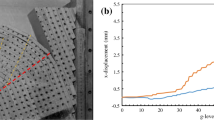Summary
Approach to Complete Limit Equilibrium Analysis for Rock Wedges — The Method of “Artificial Supports”
Since the movement of rock wedges or blocks is the primary phenomenon in rock mass failure, it is convenient to use limit equilibrium approaches for stability analysis. In spite of their wide use, limit equilibrium analysis is often restricted due to: 1) the usual procedural simplifications (regarding geometry, force application, failure modes), and 2) basic deficiencies of the limit equilibrium approach (the fundamentally indeterminate rigid body problem requires assumptions regarding the force reactions). The method of artificial supports intends to circumvent or reduce many of these restrictions. In particular, the problem of unknown force distribution on the supporting plane is reduced by specifically considering and optimizing a variety of reactions on these planes. All sliding modes of failure — i. e., translational, free and restrained rotational sliding — can be correctly modelled. Particularly significant is the result that the usual assumption oftranslational sliding can be incorrect andunsafe, if forces other than the weight are significant. The methodologies employed in the artificial support model can be extended to all modes of failure, i. e., lifting off and toppling in addition to the previously mentioned sliding modes; this is demonstrated with a procedure for a “complete” stability analysis for a 2-joint wedge.
Zusammenfassung
Ein Weg zur vollständigen Gleichgewichtsberechnung für Felskörper — Die Methode der „Künstlichen Auflager“
Da die Bewegung von Einzelblöcken das primäre Phänomen bei Felsstürzen ist, eignen sich Grenzgleichgewichtsbetrachtungen besonders gut für Stabilitätsuntersuchungen. Vor allem wegen der üblichen Vereinfachungen (Geometrie, Kräfteansätze, Versagensmechanismen) und grundlegender Unzulänglichkeiten (das grundsätzlich statisch unbestimmte Starrkörperproblem erfordert Annahmen bezüglich der Auflagerkräfte) sind solche Grenzgleichgewichtsbetrachtungen oft nur beschränkt anwendbar, obwohl sie häufig angewendet werden. Es wird versucht, mit der Methode der „künstlichen Auflager“ viele dieser Einschränkungen zu umgehen. Vor allem wird das Problem der unbekannten Spannungsverteilung in den Auflageflächen dadurch reduziert, daß mögliche Kombinationen solcher Reaktionen in die Rechnung einbezogen und optimiert werden. Alle Gleitbewegungen, seien es Translationen oder freie bzw. beschränkte Rotationen auf den Auflageflächen, können korrekt behandelt werden. Besondere Bedeutung kommt aber der Tatsache zu, daß die übliche Annahme einer translatorischen Gleitung falsch ist bzw. daß man damit auf der unsicheren Seite liegt, wenn außer dem Eigengewicht noch andere Kräfte einwirken.
Die Überlegungen, die der Modellvorstellung der „künstlichen Auflager“ zugrunde gelegt wurden, können auf alle Instabilitätsfälle ausgedehnt werden, also auch auf Abheben und Kippen zusätzlich zu den vorhin genannten Gleitbewegungen; dies wird am Beispiel einer Rechenprozedur für eine vollständige Stabilitätsuntersuchung eines Gleitkeils gezeigt.
Résumé
Tentative visant à compléter l'analyse par équilibre limite — la méthode des “supports artificiels”
Le fait que le déplacement de blocs est le principal phénomène d'instabilité en massif rocheux suggère l'utilisation de méthodes d'équilibre limite à l'étude de sa stabilité. Bien qu'elles soient fréquemment utilisées, les analyses par équilibre limite sont souvent restreintes par suite 1) de simplifications opérationnelles (concernant la géométrie, les forces et les modes d'instabilité), et 2) des insuffisances fondamentales de cette approche (le problème des corps indéformables est en essence statiquement indéterminé et réclame en conséquence l'adoption d'hypothèses sur la teneur des réactions).
L'intention de la “méthode des supports artificiels” est de réduire ou éviter plusieures de ces restrictions. En particulier le problème de la distribution inconnue des forces sur le plan d'assise est résolu en considérant et optimisant un certain nombre de réactions entre corps rigide et le plan de base. Tous les modes d'instabilité au glissement — à savoir translation, rotation restreinte et rotation libre — peuvent être correctement représentés. Spécialement digne d'intérêt est à cet égard le résultat concernant l'habituelle hypothèse de glissement en translation, puisque celui-ci peut s'avérer incorrect et exhiber des facteurs de sécurité supérieurs, par rapport à un glissement en rotation, lorsque des forces autres que le poids sont à considérer.
La méthodologie servant de base à la “méthode des supports artificiels” peut être étendue à tous modes d'instabilité, à savoir: le soulèvement et le renversement venant compléter ceux précités; ceci est illustré par le développement d'une procédure d'analyse “complète” d'un bloc monolithique découpé par deux fissures.
Similar content being viewed by others
References
Baligh, M. M., et al.: Effect of Longitudinal Stresses on Slope Stability, Manuscript submitted to ASCE Journal of the Geotechnical Division.
Einstein, H. H., Baecher, G. B., Veneziano, D., et al.: Risk Analysis for Rock Slopes in Open Pit Mines, Draft Final Report to U. S. Bureau of Mines (1979).
Glynn, E. F.: A Probabilistic Approach to Slope Stability, Ph. D. Dissertation, MIT (1979).
Goodman, R. E., Bray, J. W.: Toppling of Rock Slopes, Proceedings of Symposium on Rock Engineering for Foundations and Slopes, ASCE (1976).
Hendron, A. J., Cording, E. I., Aiyer, A. K.: Analytical and Graphical Methods for the Analysis of Slopes in Rock Masses, NCG Technical Report, No. 36 (1971).
Mahtab, M., Goodman, R. E.: Three Dimensional Analysis of Jointed Rock Slopes, Proceedings of the 2nd International Congress of the ISRM, 353–360 (1970).
St. John, C. H.: Three Dimensional Analysis of Jointed Rock Slopes, Proc. Symposium on Rock Fractures, Nancy, Paper II-9 (1971).
Wittke, W.: Verfahren zur Berechnung der Standsicherheit belasteter und unbelasteter Felsböschungen, Rock Mechanics and Engineering Geology, Suppl. II, 52–79 (1965).
Author information
Authors and Affiliations
Additional information
With 13 Figures
Rights and permissions
About this article
Cite this article
Chan, H.C., Einstein, H.H. Approach to complete limit equilibrium analysis for rock wedges — the method of “artificial supports”. Rock Mechanics 14, 59–86 (1981). https://doi.org/10.1007/BF01239856
Received:
Issue Date:
DOI: https://doi.org/10.1007/BF01239856




